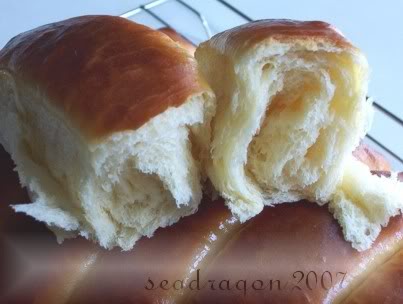Recipe from the Corner Cafe.

The soft and fluffy texture of the water-roux bun.
In 2004, a Chinese cookbook called ‘65°C湯種麵包’ was published and it soon became very popular with the Chinese bloggers. The book introduced to the Chinese baking community a new way of making soft breads and filled buns using a 65°C water-roux paste. Since then, all sorts of recipes using this method have been popping up all over the Chinese websites.
The innovation of this technique of making bread is the inclusion of a ‘water-roux (湯種 Tang Zhong)’, that is cooking portion of the flour and water first (as opposed to cooking flour and butter for a proper roux in the traditional sense) before adding it to the rest of the ingredients. The water-roux is supposed to allow the dough to absorb more liquid due to the gelatinization of the starch in the flour, thereby allowing the finished buns to have a fine soft texture and not get stale as quickly.
Any Asian-style buns made with the more traditional Sweet Bun Dough can be made using this water-roux method, thereby cutting out the need to add any artificial bread softener or improver.
The following is the basic recipe using the 65°C water-roux paste for sweet bun dough (湯種甜麵糰) to go with sweet filling. At the end of the recipe, I have also included another variation for savoury roll dough (湯種調理麵糰) to go with savoury filling, the method of preparation is the same.

Pork Floss Buns and Coconut Cream Buns made with water-roux sweet bun dough.
Japanese-Style Sweet Bun Dough 湯種甜麵糰
Makes 16 buns
[Ingredients]
375g bread flour
100g plain flour
35g milk powder
75g caster sugar
3/4 teaspoon salt
1 sachet (7g or 2 1/2 tsp) instant dry yeast
1 egg, lightly beaten
150ml (approx.) lukewarm water, adjust as necessary
40g butter, cubed
Water-Roux Paste (湯種) *:
25g (just under 2 tbsp) bread flour
125ml (1/2 cup) water
* Water-Roux is basically 1 part bread flour to 5 parts water.
http://cornercafe.wordpress.com/
[Preparation]
Water-Roux (湯種):
Mix flour and water in a small saucepan. Cook over low to medium heat, stirring continuously until it reaches 65ºC. It should have thickened to a paste at this stage, that is when you stir you can see the bottom of the pan. Remove from heat, place a cling film over the paste and leave until lukewarm, or room temperature, before using. (Alternatively if you don’t have a thermometer, cook as before until it starts to thicken, then continue to cook for about 1 more minute before removing from heat.) This water roux can be kept in an airtight container after cooling in the refrigerator for 1 day if not used immediately. However DO NOT USE if it turns grey in colour, that means it has gone bad.
For the Bun Dough:
1. Sift bread flour, plain flour, milk powder, caster sugar and salt onto the working surface. Add instant dry yeast and mix well. Form the flour mixture into a well. Add lightly beaten egg and lukewarm water roux and mix in. Gradually add just enough lukewarm water to form into a slightly sticky, soft dough. Knead for 10 minutes until smooth and elastic. During hand kneading, the dough also needs to be thrown onto the working surface once every few minutes between kneading to improve the dough structure. (I usually just pick up the dough to about head-high and throw it down onto the working surface 10 to 20 times every few minutes between kneading.)
2. Knead in butter until incorporated. (In many cookbooks, they mentioned that the dough at this stage should be able to be pulled and stretched into membrane, but it’s hard to achieve with hand kneading. I usually stop kneading when the dough sticks to the work surface and stretches like chewing gum when pulled!) Form the dough into a round ball and let it rise until double in size in a large greased bowl, cover with cling film (should take about 1 hour in warm weather, longer in winter months). Optimum room temperature for this first prove is 28°C with a humidity of 75%. To test if the dough has risen properly, dip a finger into bread or plain flour and poke down into the centre of the dough as far as your finger will go and pull out again – the hole should remain if it is ready. If the dough springs back, then it is not ready, continue to prove further.
3. Punch down, knead briefly and form into a ball shape. Then divide into 16 equal portions. The easiest way is to first divide equally into 4 larger portions first, then divide each of these again into quarters each. Form each into balls and let rest for 10 minutes.

Plain water-roux buns before final proving..
4. Shape and fill the buns according to recipe. Place all finished buns on a greased baking sheet, lightly cover with cling film, and let rise until double in size (about 1 hour in warm weather, longer in winter months). Optimum room temperature for this final prove is 38°C with a humidity of 85%.

Plain water-roux buns after final proving (double in size).
5. Bake in preheated 190°C oven for about 12 to 15 minutes, or until golden brown.

Plain water-roux buns after baking.
[Variations]
This is a variation of the above recipe for use with savoury filling, the preparation is the same as above:

Savoury buns such as Hotdog Buns and Ham Buns made with water-roux bun dough.
Japanese-Style Savoury Roll Dough 湯種調理麵糰
Makes 16 buns
[Ingredients]
325g bread flour
150g plain flour
20g milk powder
50g caster sugar
1 teaspoon salt
1 sachet (7g or 2 1/2 tsp) instant dry yeast
2 eggs, lightly beaten
100ml (approx.) lukewarm water, adjust as necessary
75g butter, cubed
Water-Roux Paste (湯種) *:
25g (just under 2 tbsp) bread flour
125ml (1/2 cup) water

The texture of the Pai Pau made with water-roux bun dough.
